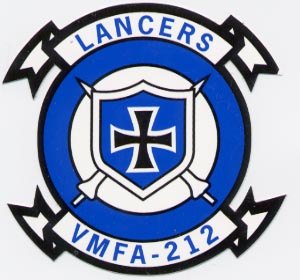
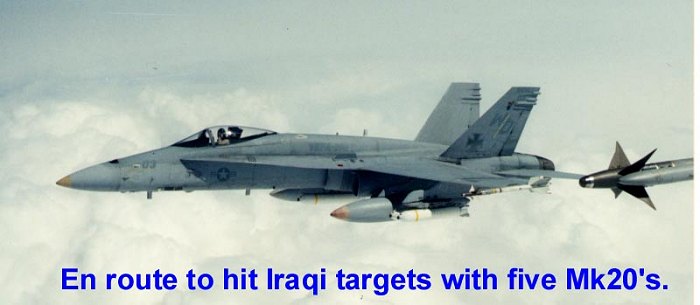
|
Sheet # |
Repliscale 48-5039 |
|
Price: |
$ |
|
Units: |
see review |
|
Review By: |
|
|
Notes: |
|


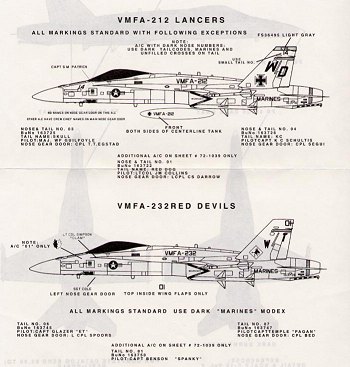 VMFA-212 "Lancers", VMFA-232
"Red Devils" and VMFA-235 "Death Angels" were the last
active-duty squadrons in the Marine Corps and Navy to retire the venerable F-4
Phantom. Some reserve Navy and Marine squadrons had already been operating
F/A-18 Hornets for a few years when these MCAS Kaneohe Bay squadrons finally
gave up the old Rhino. In compensation for operating the older plane for so
long, all three were the first Marine squadrons to transition to the C model of
the Hornet. These jets were less than two years old when the Iraqi army invaded
Kuwait in 1990. All combat units at MCAS Kaneohe Bay ("K-Bay")
deployed to the Persian Gulf region by the end of the year. The infantry
regiment and artillery battalion dug- in on the Saudi Arabian border with
Kuwait, and the Hornet squadrons settled in at the airfield at Shaikh Isa
(a.k.a. Shakeyís Pizza) on the island of Bahrain. At that time the C model of
the Hornet was so new that these three squadrons flew the only Cís out of
Shaikh Isa. After the liberation of Kuwait, all the units eventually returned to
K-Bay.
VMFA-212 "Lancers", VMFA-232
"Red Devils" and VMFA-235 "Death Angels" were the last
active-duty squadrons in the Marine Corps and Navy to retire the venerable F-4
Phantom. Some reserve Navy and Marine squadrons had already been operating
F/A-18 Hornets for a few years when these MCAS Kaneohe Bay squadrons finally
gave up the old Rhino. In compensation for operating the older plane for so
long, all three were the first Marine squadrons to transition to the C model of
the Hornet. These jets were less than two years old when the Iraqi army invaded
Kuwait in 1990. All combat units at MCAS Kaneohe Bay ("K-Bay")
deployed to the Persian Gulf region by the end of the year. The infantry
regiment and artillery battalion dug- in on the Saudi Arabian border with
Kuwait, and the Hornet squadrons settled in at the airfield at Shaikh Isa
(a.k.a. Shakeyís Pizza) on the island of Bahrain. At that time the C model of
the Hornet was so new that these three squadrons flew the only Cís out of
Shaikh Isa. After the liberation of Kuwait, all the units eventually returned to
K-Bay.
Repliscale sheet 48-5039
depicts VMFA-212 "Lancers" and VMFA-232 "Red
Devils" as they appeared during both Desert Shield and Desert Storm and
the few years afterward. There isnít much color on these jets except the red
and white head on the Red Devil COís jet. (Having observed the real jets at
K-Bay until 1994, I can tell you that the jets were pretty much marked like this
the entire time, lo-vis gray.) The sheet provides the option to do one of six
aircraft 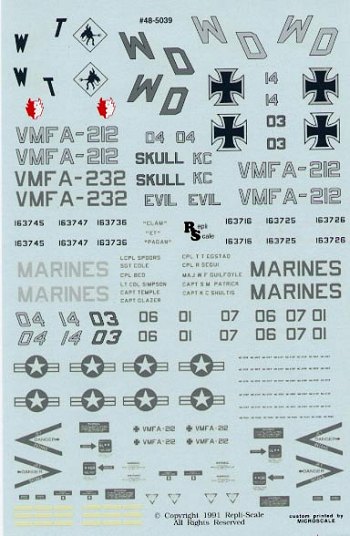 from both
squadrons. The Lancer jets are unique in that the pilot whose name appears on
the canopy rail also has his callsign painted on the tail. When I originally
purchased this sheet in 1992, ended up using the markings for Lancer 03 because
I thought the callsign "Skull" was cool. [Major Guilfoyle was the
Operations Officer (S-3) with VMFA-212. It was his second tour with VMFA-212.
The first tour was when they flew F-4 Super-Jís (F-4Sís without slats)]. The
markings are all in the typical shades of lo-vis gray, except for the
aforementioned on the Red Devil COís jet. The national insignia look sort of
weird so they warrant replacement with substitutes from another source. Back in
1992, some of the stencils and pilots names disappeared against the Gunze-Sangyo
colors I used. (Maybe it was the fact that I applied them without an airbrush.
Living in the barracks at that time dictated using acrylics and handpainting.)
The squadron markings and individual plane numbers turned out fine. There are
only enough common stencils to do two aircraft, so that combined with the
aforementioned disappearing stencils warrants replacement with another source.
With careful planning and stencils from another source, its possible to do one
Red Devil and two Lancer jets from this sheet. I didnít notice it then, but Lance
Corporal Dave Roof appears as one of the contributors. For a bright version
of the Red Devil COís jet go here.
from both
squadrons. The Lancer jets are unique in that the pilot whose name appears on
the canopy rail also has his callsign painted on the tail. When I originally
purchased this sheet in 1992, ended up using the markings for Lancer 03 because
I thought the callsign "Skull" was cool. [Major Guilfoyle was the
Operations Officer (S-3) with VMFA-212. It was his second tour with VMFA-212.
The first tour was when they flew F-4 Super-Jís (F-4Sís without slats)]. The
markings are all in the typical shades of lo-vis gray, except for the
aforementioned on the Red Devil COís jet. The national insignia look sort of
weird so they warrant replacement with substitutes from another source. Back in
1992, some of the stencils and pilots names disappeared against the Gunze-Sangyo
colors I used. (Maybe it was the fact that I applied them without an airbrush.
Living in the barracks at that time dictated using acrylics and handpainting.)
The squadron markings and individual plane numbers turned out fine. There are
only enough common stencils to do two aircraft, so that combined with the
aforementioned disappearing stencils warrants replacement with another source.
With careful planning and stencils from another source, its possible to do one
Red Devil and two Lancer jets from this sheet. I didnít notice it then, but Lance
Corporal Dave Roof appears as one of the contributors. For a bright version
of the Red Devil COís jet go here.
A few words about the Hornets depicted on these sheets. As said, these jets were early F/A-18Cís. If you are going to use the Hasegawa kit, fill in doors 5L and 5R. Sand off the antennas behind the intakes. Omit the braces inside the tail fins. The rest can be built straight out of box. If you are going to use the Revell-Monogram kit, fill-in the square screens on the spine behind the canopy, and also the vents on the inboard and outboard surfaces in the "forward corner" of both fins. Sand a ľ inch of the Sparrow fairings flush on the forward end. These features were found on the prototype, not production Hornets. The rest can be built straight out of box.
A few years later, Repliscale went out of business and I was searching for the same sheet again. A request posted on RMS yielded a positive response from a Marine who worked at a hobby shop near Camp Pendleton. That Marine was Dave Roof. It turned out that we were both with Marine Air Group 46 at NAS/MCAS Miramar. Around that time, I learned that William "Skull" Guilfoyle had been promoted to Lieutenant Colonel and had returned to VMFA-212 for a third time, as CO of the squadron. After a short correspondence with him via email, he sent me the attached photos of the real Lancer 03 and himself. I finally learned why his callsign was "Skull".
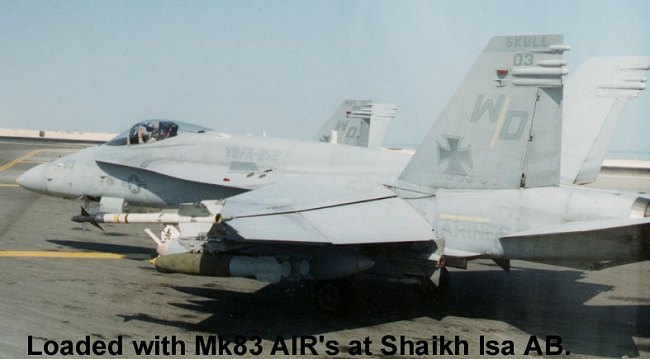
If you would like your product reviewed fairly and quickly by a site that averages over 2,000 visits a day, please contact me or see other details in the Note to Contributors.